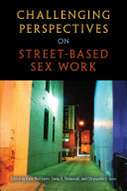Challenging Perspectives On Street-Based Sex Work

Editors: Katie Hail-Jares, Corey S. Shdaimah, and Chrysanthi S. Leon
Publisher: Philadelphia: Temple University Press, 2017. 308p.
Reviewer: Emily van der Meulen | July 2018
Hail-Jares, Shdaimah, and Leon open and close their edited collection on street-based sex work with an apt discussion of Monica Jones, a student in the School of Social Work at Arizona State University who faced a thirty-day prison sentence for asking an undercover police officer if he was indeed a police officer. This question was, and still is, an offence under Phoenix’s draconian law against “manifesting prostitution,” if the enquirer engages in (or is assumed to engage in) sex work. Jones’s case made international headlines in 2013 for exposing the hypocrisy and absurdity of anti-prostitution policies and interventions, which included her own university department’s partnership with city police in a deeply mis-guided attempt to “rescue” street-based sex workers, dubbed Project ROSE. Those detained as part of the street-sweeps were offered a choice between enrolling in a diversion or “exit” program (provided they had no previous criminal charges for prostitution) or, if they declined or were deemed ineligible, jail time.
By bookending the edited collection with this case study, Hail-Jares, Shdaimah, and Leon provide an important framework for the (mostly) critical analyses in the intervening chapters. In an effort to move beyond the age-old reductionist trope that sex workers are either victims or criminals – a fallacy so clearly deployed by Project ROSE, and even advanced by a few of the book’s own authors – this new addition to the field of sex work studies is largely successful in fulfilling the goal set out in its title: Challenging Perspectives on Street-Based Sex Work. Focusing primarily on the United States, though also providing a small glimpse into the situation in Thailand, many of the chapters provide insightful and nuanced analyses of how sex workers are affected by criminalization, policing, anti-trafficking campaigns, gentrification, poverty, racism, transphobia, violence, stigma, and more. Importantly, some of the authors also highlight sex workers’ resistance and resilience in the face of these and other social inequities.
A key strength of the collection is the inclusion of a small number of chapters by current or former sex workers themselves. These works ground the book in experiential knowledge, thereby providing readers with a more fulsome and candid representation of diverse sex workers’ experiences while also working toward bridging the “campus-community” divide. In doing so, the editors are adding to the growing number of books published by university and scholarly presses that include non-academic sex workers’ writings on par with those of non-sex-working academics (recognizing, of course, that there are many who work, or have worked, both in the sex industry and in the academy).
While the collection has many strengths, there are some shortcomings as well. The editors’ description of street- and hotel-based sex workers as “lower-echelon,” for example, seems to uphold rather than undermine the conventional notions and stereotypes the book is trying to refute. More significantly, and incongruous to the chapters by sex workers and allied researchers, the book includes regressive pieces by representatives of criminal justice institutions and agencies that cause manifold harms in sex workers’ lives. These works are problematic and unhelpful, especially when not directly accompanied by an in-depth and critical analysis. Adding more content by sex workers in place of those chapters would have been favourable. Despite these issues, the collection as a whole does a solid job of advancing both scholarship and public discourse on street-based sex work, and is thus recommended for reading.
Emily van der Meulen is an Associate Professor in the Department of Criminology at Ryerson University, Toronto, Canada.


